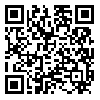Volume 10, Issue 3 (Occupational Medicine Quarterly Journal 2018)
tkj 2018, 10(3): 1-12 |
Back to browse issues page
Download citation:
BibTeX | RIS | EndNote | Medlars | ProCite | Reference Manager | RefWorks
Send citation to:



BibTeX | RIS | EndNote | Medlars | ProCite | Reference Manager | RefWorks
Send citation to:
Mazloumi A, Paykari A, Halvani G, Ghaneh S, Mashayekhi M. Validation and reliability study of a ventilator usability assessment tool. tkj 2018; 10 (3) :1-12
URL: http://tkj.ssu.ac.ir/article-1-869-en.html
URL: http://tkj.ssu.ac.ir/article-1-869-en.html
Tehran University of Medical Sciences , amazlomi@tums.ac.ir
Full-Text [PDF 996 kb]
(820 Downloads)
| Abstract (HTML) (3355 Views)
Validation and reliability study of a ventilator usability assessment tool
Paykari A1(MSc), Mazloumi A2*(PhD), Halvani GH3(MSc),.Ghaneh S4(PhD),
Mashayekhi M5(PhD)
1 MSc, Student, Ergonomics Department, Faculty of Health, Shahid Sadoughi University of Medical Sciences, Yazd, Iran.
2 Associate Professor, Department of Occupational Health Engineering, Faculty of Health, Tehran University of Medical Sciences, Tehran, Iran.
3 Assistant Professor, Ergonomics Department, Faculty of Health, Shahid Sadoughi University of Medical Sciences, Yazd, Iran
4 PhD student ergonomics, Department of Occupational Health Engineering, Faculty of Health, Tehran University of Medical Sciences, Tehran, Iran.
5 PhD student Biomechanics, Biomedical Engineering, Amir Kabir Hospital, Arak, Markazi, Iran
Abstract
Introduction: Usability is an index to assess a product from the viewpoint of user's satisfaction, efficiency and productivity improvement. The main attributes of usability that are derived from the human factors and are used in usability design of the interfaces include: compatibility, consistency, flexibility, minimal action, perceptual limitation, usefulness, learnability, ease of use, minimal memory load, user guidance, satisfaction and errors. The main aim of this study was to assess the usability of interface design tool for a ventilator utilized in the hospitals of Arak city, Iran, and to study its validation and reliability.
Methods: After constructing the initial questionnaire from the standard sources, specific techniques to determine the validity, and Cronbach's alpha coefficient were used for the validity and reliability study. The study procedure was determining the scope and dimensions of the questions, drafting questionnaire, assigning members of the expert panel, study, questionnaire data acquisition and analysis methods, determining acceptance criteria of the questions and the content validity and reliability index. Final tool was a 42-items questionnaire.
Results: The content validity index (CVI) of questionnaire was 0.86. The results showed that the total Cronbach's alpha coefficient was 0.89 as an acceptable value for the reliability of questionnaire.
Conclusion: After designing the final questionnaire, and the reaching to the appropriate validity and reliability, adopting this tool to assess the usability of breathing apparatus (ventilator) is recommended. With usability assessment of such vital instruments, quality improvement, higher efficiency and productivity as well as errors reduction and good design user interface will be achieved.
Keywords: Usability, Ventilator, Evaluation questionnaire, Content validity, Reliability
*Corresponding Author:
Tel: +98 2188951390
Email: amazlomi@tums.ac.ir
Received: 2017.06.10 accepted: 2017.09.02
Full-Text: (953 Views)
Validation and reliability study of a ventilator usability assessment tool
Paykari A1(MSc), Mazloumi A2*(PhD), Halvani GH3(MSc),.Ghaneh S4(PhD),
Mashayekhi M5(PhD)
1 MSc, Student, Ergonomics Department, Faculty of Health, Shahid Sadoughi University of Medical Sciences, Yazd, Iran.
2 Associate Professor, Department of Occupational Health Engineering, Faculty of Health, Tehran University of Medical Sciences, Tehran, Iran.
3 Assistant Professor, Ergonomics Department, Faculty of Health, Shahid Sadoughi University of Medical Sciences, Yazd, Iran
4 PhD student ergonomics, Department of Occupational Health Engineering, Faculty of Health, Tehran University of Medical Sciences, Tehran, Iran.
5 PhD student Biomechanics, Biomedical Engineering, Amir Kabir Hospital, Arak, Markazi, Iran
Abstract
Introduction: Usability is an index to assess a product from the viewpoint of user's satisfaction, efficiency and productivity improvement. The main attributes of usability that are derived from the human factors and are used in usability design of the interfaces include: compatibility, consistency, flexibility, minimal action, perceptual limitation, usefulness, learnability, ease of use, minimal memory load, user guidance, satisfaction and errors. The main aim of this study was to assess the usability of interface design tool for a ventilator utilized in the hospitals of Arak city, Iran, and to study its validation and reliability.
Methods: After constructing the initial questionnaire from the standard sources, specific techniques to determine the validity, and Cronbach's alpha coefficient were used for the validity and reliability study. The study procedure was determining the scope and dimensions of the questions, drafting questionnaire, assigning members of the expert panel, study, questionnaire data acquisition and analysis methods, determining acceptance criteria of the questions and the content validity and reliability index. Final tool was a 42-items questionnaire.
Results: The content validity index (CVI) of questionnaire was 0.86. The results showed that the total Cronbach's alpha coefficient was 0.89 as an acceptable value for the reliability of questionnaire.
Conclusion: After designing the final questionnaire, and the reaching to the appropriate validity and reliability, adopting this tool to assess the usability of breathing apparatus (ventilator) is recommended. With usability assessment of such vital instruments, quality improvement, higher efficiency and productivity as well as errors reduction and good design user interface will be achieved.
Keywords: Usability, Ventilator, Evaluation questionnaire, Content validity, Reliability
| This paper should be cited as: Paykari A, Mazloumi A, Halvani GH,.Ghaneh S, Mashayekhi M. Validation and reliability study of a ventilator usability assessment tool. Occupational Medicine Quarterly Journal 2018; 10(3):1-12. |
*Corresponding Author:
Tel: +98 2188951390
Email: amazlomi@tums.ac.ir
Received: 2017.06.10 accepted: 2017.09.02
Type of Study: Applicable |
Subject:
Ergonomics
Received: 2017/06/4 | Accepted: 2017/08/31 | Published: 2019/05/4
Received: 2017/06/4 | Accepted: 2017/08/31 | Published: 2019/05/4
Send email to the article author
| Rights and permissions | |
 |
This work is licensed under a Creative Commons Attribution-NonCommercial 4.0 International License. |







